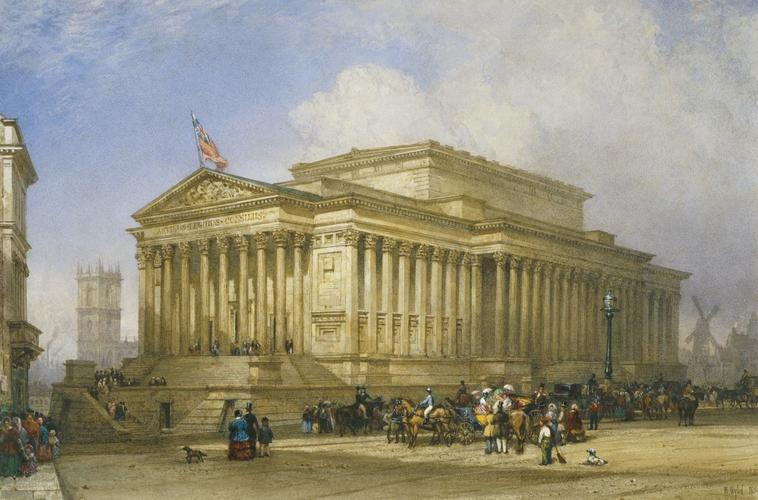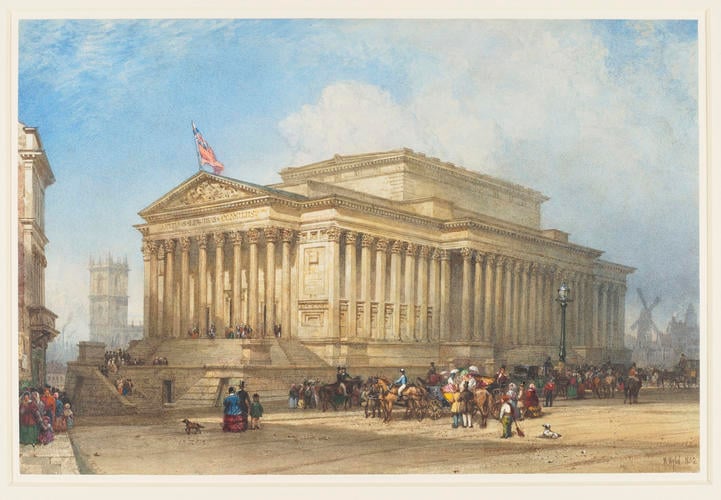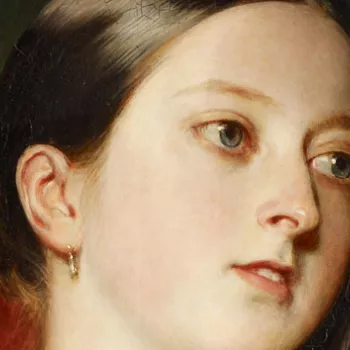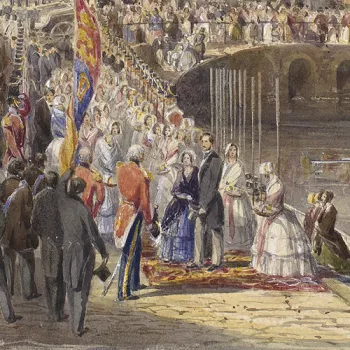St George’s Hall, Liverpool dated 1852
Pen and ink, watercolour and bodycolour, with touches of gum arabic | 32.2 x 48.3 cm (sheet of paper) | RCIN 920219

William Wyld (1806-89)
St George’s Hall, Liverpool dated 1852

William Wyld (1806-89)
St George?s Hall, Liverpool dated 1852


-
A watercolour depicting the exterior view of a classical neo-grecian building, with columns at the front and on the side, designed by Harvey Lonsdale Elmes. Figures and carriages are visible in the foreground. Signed and dated at lower right: "W. Wyld 1852". Inscribed and dated in a later hand on the verso.
William Wyld was born in London but spent most of his life in France. After working for the British Consul in Calais and then going into the wine trade, he became a full-time watercolourist in 1834, influenced by the luminous works of the similarly expatriate Richard Parkes Bonington (1802-28). Queen Victoria first saw Wyld’s work in 1843 in the collection of her aunt Louise, Queen of the Belgians, choosing some of those watercolours for her own collection, and Louise subsequently ordered more works from Wyld to send to Victoria. The artist was invited to stay at Balmoral in September and October 1852, writing in a letter to a friend, ‘I am well and getting on very well with Her Majesty, who altho’ a Queen is one of the most amiable women I ever spoke to, and so completely does she put you at your ease that I am no more embarrassed in talking to her than to you.’
The Queen and Prince Albert visited Liverpool on 9 October 1851 and Manchester over the following two days, and commissioned a watercolour of each of the cities from Wyld soon after; £73 10s for the pair was paid to the artist in April 1852. The civic highlight of Liverpool was the great neo-Grecian St George’s Hall, the interiors of which were still under construction when Victoria visited the city. It was designed by Harvey Lonsdale Elmes, who in 1839, at the age of twenty-five, had won a competition for a concert hall to be built in Liverpool by public subscription. The following year he won an ancillary competition for a court building, but contributions for the concert hall were meagre, and the city took over that project and decided to combine the two buildings in one. Elmes’s final plans date from 1841; he died in 1847, and Charles Cockerell (1788-1863) saw the building through to completion in 1856.
Victoria thought St George’s Hall was ‘one of the finest modern buildings imaginable, quite worthy of ancient Athens ... The taste is so good & the style so pure ... Albert, whose great mind is always so ready to admire & approve all that is vast, great & grand, was delighted. He never really admires what is small in purpose & design, & frittered away in detail.’
Text adapted from Holbein to Hockney: Drawings from the Royal Collection, London, 2004.
This watercolour was originally mounted in View Album V. Queen Victoria and Prince Albert compiled nine View Albums during their marriage. These albums contained watercolours and drawings documenting their life together and were arranged in chronological order. The albums were dismantled in the early twentieth century and rebound in new volumes both in a different arrangement and with additional items, but a written record of their original contents and arrangement still exists.Provenance
Commissioned by Queen Victoria in 1851 for her View Album
-
Creator(s)
-
Medium and techniques
Pen and ink, watercolour and bodycolour, with touches of gum arabic
Measurements
32.2 x 48.3 cm (sheet of paper)
Object type(s)
Subject(s)
Other number(s)
RL 20219Alternative title(s)
Liverpool: St George’s Hall









